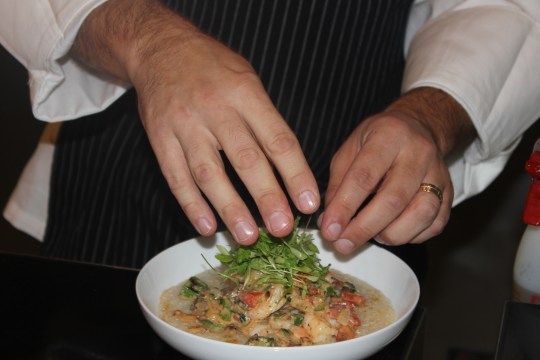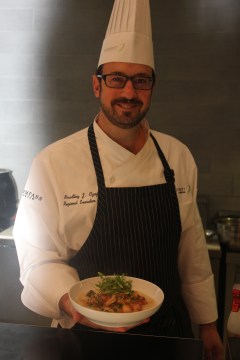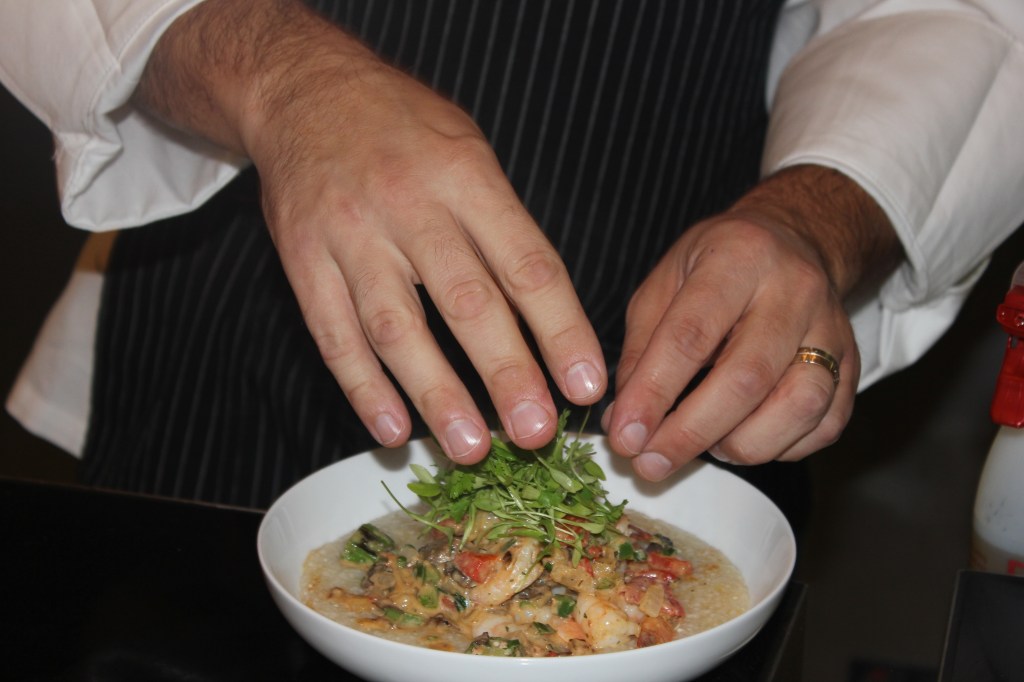
The “old world” of hospital meals included such institutional staples as spaghetti and meat sauce, beef stew and chicken pot pie. It was bland, filling and familiar . . . and not all that healthy.
“There were a lot of canned and frozen vegetables seasoned heavily, and a very limited salad bar,’’ says Lenny Scranton, a regional vice president of Morrison Healthcare, a food and nutrition services company.
In hospital rooms, patients had very little control over meal times or selections.
The “new world” of hospital cuisine has a much fresher look. Hospitals have a culinary-trained chef in the kitchen, Scranton says. Cafeterias offer fresh vegetables, main courses such as grilled fish and chicken, and a robust salad bar. And the food has much less salt, less fat, less refined carbohydrates.
Patients get a choice of offerings, including fresh vegetables, grilled items — and smaller desserts.
The sea change in hospital food over the past 20 years has mirrored society’s overall emphasis on healthier food.
Atlanta-based Morrison Healthcare, part of the Compass Group North America, has been a big part of that transition.
The forerunner of the company was Morrison’s Cafeterias, a chain of Southern-style eateries founded in Mobile, Ala., in the 1920s. The current company decided to provide food services exclusively to hospitals and other health care facilities in 1997. (There is no remaining affiliation with Morrison’s Cafeterias, which shed its name and merged into the Piccadilly restaurant chain several years ago.)
Morrison now serves 630 hospitals and health care systems.
Clout put to good use
The evolution of hospital menus, brought about by Morrison and other companies, has punctured the traditional bad rap against hospital food. Many hospitals even have their own gardens to grow their produce.
And in a sign of real progress, the cafeterias are serving more “retail meals.” In other words, they are drawing more paying customers.
Modern Healthcare reported recently that hospitals served an average of more than 1,000 retail meals a day last year, up 2.9 percent from the year before. Those meals accounted for 58 percent of all meals served at hospitals that reported offering both retail and patient food services.
Many hospitals still offer retail outlets with less-than-healthy ‘”fast food.” Yet reflecting the general push for wellness, the renowned Cleveland Clinic in Ohio announced this month it would sever ties with McDonald’s, and the outlet there will close in September.
Morrison’s work on improving food options was highlighted in a CDC case study that noted the company’s changes to its retail menu in 2013. The result featured at least 60 percent healthy offerings, including lower-sodium options. Morrison modified its cooking methods, used more seasonal and sustainable foods, incorporated more whole grains and reduced portion sizes.
“We are so large that we can go to food manufacturers and get them to reformulate,’’ says R.J. Harvey, a corporate executive chef with Morrison.
“We’re removing salt and saturated fat, using fresh herbs and spices instead of salt,” Harvey says.
The CDC study says that “although some of the new ingredients were more expensive, Morrison’s large buying power and participation in a group purchasing organization protected their bottom line.”
Harvey admits there has been a little bit of pushback against the new hospital meals, because some people still prefer such fare as fried chicken and macaroni and cheese. But he emphasizes that what’s now being offered is not some pale imitation of home cooking. It’s the real thing, wholesome and expertly prepared.
“We do cook mostly from scratch in our kitchen,’’ he says.
Morrison can charge a little bit more because it serves healthier food, Harvey adds. Morrison officials say they work to keep costs as low as possible for clients.
Twenty years ago, hospitals heavily subsidized their food service, Scranton says. “Today, that subsidy can be heavily offset if they have [good] food.”
The quality of food that patients are served can figure into how satisfied they are with the hospital. And that’s important nowadays.
The hospital consumer survey poses questions to patients about a wide range of topics, including communication with doctors and nurses, pain management and cleanliness of the hospital environment. Medicare uses the survey to award a hospital a star rating, ranging from one star to five.
Scranton notes that the HCAPPS survey does not contain any questions about food, but he says hospitals agree that food has an impact on overall satisfaction.
An accent on freshness
Navicent Health in Macon, one of Morrison’s clients, revamped its menus two years ago.
The goals included offering greater choice to patients, allowing them to order from the same menu, regardless of health condition; reducing the percentage of fried foods; providing smaller portions of sugar-sweetened beverages; and using whole grains as an alternative to rice.
“We’ve really made it a conscious effort,’’ says Millie Smith, the clinical dietitian supervisor for nutrition services at Navicent Health. “Younger patients are used to more healthy food.”
But the new type of fare was a huge culture change for some older patients, “who are used to eating more fried and processed food,’’ she adds.
Under the new menus, less sodium and fat are added to the food. Dessert portions are smaller.

“It doesn’t have to be a really costly venture’’ to change what’s served, Smith says, noting that using produce when it’s in season is one economical measure.
Even the vending machines got a makeover, says Kevin Carter, Navicent Health’s director of wellness services. Healthier options such as granola bars have replaced gooey candy.
“Morrison is always looking for the next thing, the next menu option,’’ Carter says. “It benefits patients, visitors and our employees. “
Children’s Healthcare of Atlanta, another Morrison client, combines an emphasis on nutrition and fitness for employees.
Lauren Lorenzo, manager of employee wellness at Children’s, said the hospitals offer a $1 healthy food option for employees and families.
“The feedback has been great,’’ she says.
“We are a health care organization,’’ Lorenzo adds. “We want people to be healthy . . . so they can take care of the kids. Healthy people are productive and make good decisions.”




